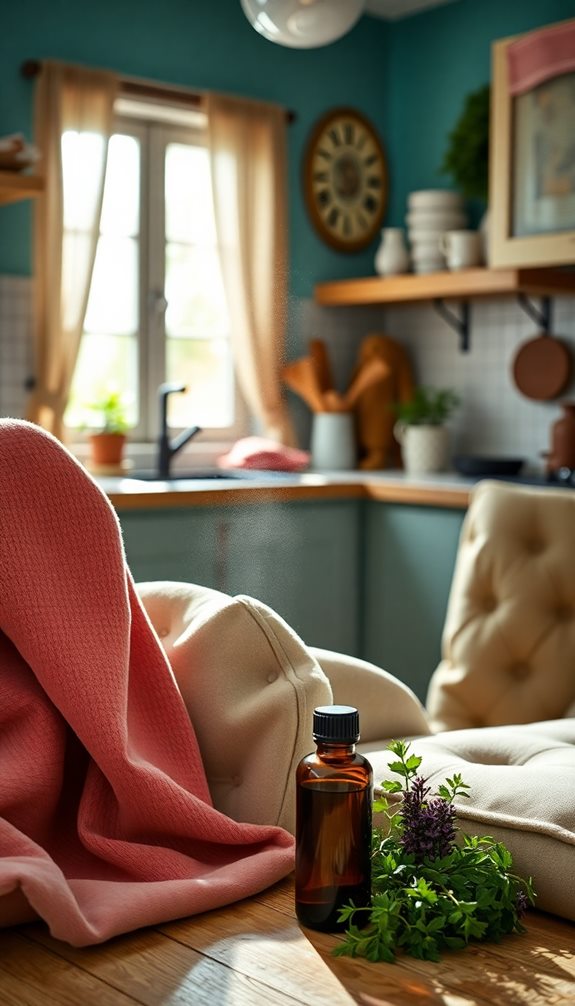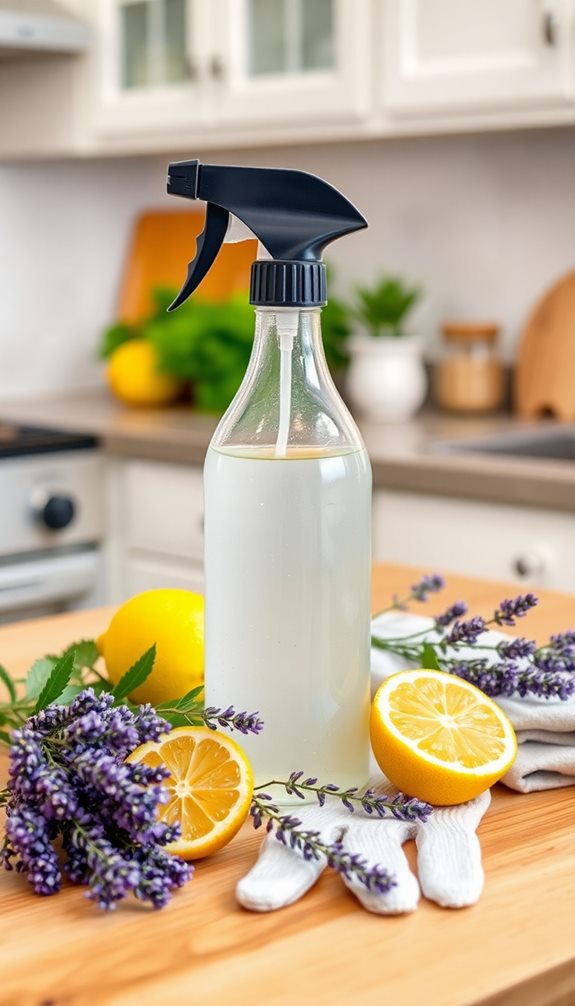Making your own fabric refresher is simple and cost-effective. Start with a glass spray bottle and pour in 1/4 cup of high-proof vodka or rubbing alcohol to neutralize odors. Next, add 10-30 drops of your favorite essential oil for a personalized scent. Fill the bottle with 1.5 cups of distilled water to dilute the mixture. Shake well before using. This refreshes fabrics like cotton and polyester while minimizing harmful chemicals. Remember to conduct a patch test on delicate materials first. Keep going to discover more tips and tricks for your homemade fabric refresher!
Benefits of Homemade Fabric Refresher
Making your own fabric refresher offers several compelling benefits that make it a practical choice for any household. One of the biggest advantages is cost-effectiveness; a homemade fabric refresher typically costs under 50 cents per bottle, which is a fraction of what you'd pay for commercial options.
You also get the freedom to customize scents, allowing you to select your favorite essential oils for a personalized fragrance experience. By opting for natural ingredients, you can also align with eco-friendly practices that reduce your carbon footprint, similar to the benefits of choosing sustainable bed linens.
Using natural ingredients in your DIY fabric refresher means you're reducing your exposure to harmful chemicals often present in store-bought products, like phthalates and formaldehyde. Plus, these eco-friendly options minimize plastic waste, as you can refill reusable spray bottles instead of relying on single-use plastic.
Regularly using your homemade fabric refresher can also contribute to a healthier indoor environment. Many essential oils possess antimicrobial properties, helping you eliminate odors while reducing allergens and bacteria.
This means you not only freshen up your fabrics but also promote a cleaner living space. With all these benefits, it's clear that a homemade fabric refresher is a smart choice for sustainability, health, and fragrance.
Essential Ingredients Required
To whip up your own fabric refresher, you'll need a few essential ingredients that are easy to find. Start with a spray bottle, preferably glass, since it helps maintain the shelf life of your fabric refresher spray and prevents chemical leaching.
The primary ingredient is 1/4 cup of high-proof vodka or rubbing alcohol, which serves as a natural odor neutralizer and evaporates quickly. Using natural ingredients aligns with non-toxic cleaning practices that are safe for your home environment.
Next, add 1.5 cups of distilled water. This choice is vital because it reduces the risk of bacterial growth and avoids mineral deposits that tap water might leave behind.
For that lovely scent, incorporate 10-30 drops of your favorite essential oil blends, like lavender or lemon, which not only freshen up your fabrics but also possess antimicrobial properties.
If you want to boost deodorization, consider adding 1 tablespoon of baking soda. Just be cautious, as it can leave white spots on fabrics if not mixed well.
These simple ingredients will help you create an effective and natural fabric refresher that keeps your home smelling fresh and inviting.
Step-by-Step Preparation

Gather your supplies to start creating your fabric refresher. You'll need a glass spray bottle, 1/4 cup of high-proof vodka or rubbing alcohol, 1/2 cup of distilled water, and 10-15 drops of your chosen essential oil for fragrance.
First, pour the vodka or rubbing alcohol into the spray bottle. Next, add the essential oil, mixing them together to create a fragrant base for your DIY natural fabric refresher.
After that, slowly add the distilled water to dilute the mixture, making sure that the spray remains effective.
Once all ingredients are in the bottle, put the lid on tightly and shake it well to confirm everything is thoroughly mixed.
Remember to shake the bottle before each use, as the components may separate over time. If you want enhanced deodorization, consider adding 1 tablespoon of baking soda, but keep in mind it may leave white spots on fabrics and could clog some spray nozzles.
Tips for Effective Use
Using your fabric refresher effectively can make a significant difference in maintaining a fresh and clean environment. To get the best results, always shake the spray bottle well before each use. This guarantees that the ingredients are thoroughly mixed, providing peak effectiveness.
Incorporating natural ingredients like essential oils can enhance the invigorating quality of your spray, drawing inspiration from eco-friendly cleaning solutions that prioritize a healthier indoor environment. Before you spray your fabric liberally, conduct a patch test on a small, inconspicuous area to check for any adverse reactions or staining.
For application, choose a well-ventilated area; this helps the scent to disperse and allows the sprayed fabric to air dry completely before you use it. When making your refresher, opt for distilled water instead of tap water. This minimizes the risk of bacterial growth and prevents mineral deposits that can affect your spray's performance.
Don't hesitate to experiment with different essential oil blends to find a scent that suits your preferences. A personalized blend can enhance the freshness of your space and make your fabric refresher even more enjoyable to use.
Applications for Different Fabrics

When using fabric refresher, it's essential to take into account the type of fabric you're treating. Some materials, like silk and leather, can be sensitive and may require patch testing to avoid damage.
Regular maintenance, including vacuuming upholstered chairs and addressing spills immediately, can help maintain the integrity of your fabrics.
Suitable Fabric Types
Which fabric types can benefit most from your homemade fabric refresher?
You'll find that suitable fabric types include cotton, polyester, and various blends, which are safe for using your homemade fabric spray. These materials typically won't risk staining or damage, making them dependable choices.
Natural fibers, such as linen and wool, can also benefit from fabric refreshers, but it's essential to perform a patch test first. This guarantees the ingredients in your spray won't cause any adverse reactions.
When it comes to upholstery fabrics, like those on your couches and chairs, they usually respond very well to fabric refresher sprays. Not only do they help eliminate odors, but they also leave a fresh scent that enhances your living space.
However, be cautious with delicate fabrics, such as silk and leather. These materials should be avoided, as they may become discolored or damaged by the components in your homemade refresher.
If you need to refresh fabrics stored in closets or drawers, like linens or clothing, your fabric refresher can maintain a pleasant smell without harming the materials.
Stain Sensitivity Considerations
Before applying your homemade fabric refresher, it's important to contemplate how different fabrics react to various ingredients. Stain sensitivity considerations are vital, especially with delicate materials like silk, cashmere, and leather. Always conduct a spot test on these fabrics to verify they won't react negatively to the refresher.
You should avoid using your fabric refresher on items that might stain easily, particularly those with intricate dyes or patterns, as some ingredients used could cause discoloration.
In contrast, fabrics like polyester and cotton typically handle homemade fabric refreshers well and can be applied more liberally without worry.
When it comes to upholstery, remember to test a small, inconspicuous area first. This verifies the fabric surfaces can withstand the spray without damage or color loss.
Additionally, if your refresher contains baking soda, be cautious; it can leave white spots on darker fabrics if not mixed properly or applied too heavily.
Patch Testing Importance
Testing your fabric refresher on a small spot is key to preventing any unwanted damage or discoloration, especially with sensitive materials like silk, wool, or cashmere.
Patch testing allows you to see how different fabric types react to the ingredients in your homemade refresher. To do this, apply a small amount to an inconspicuous area and wait 24 hours. This simple step helps you avoid potential stains or adverse reactions.
It's particularly important to test fabrics treated with essential oils. Some oils can stain or leave a residue, especially on lighter-colored materials.
Community Feedback and Experiences
Homemade fabric refresher sprays have garnered a wave of positive feedback from users who appreciate their effectiveness in eliminating odors from various fabrics. Many users report a significant reduction in unwanted smells after switching to these DIY fabric fresheners, finding them far superior to commercial products.
The community shares their favorite essential oil combinations, with lavender and lemon being popular for their delightful and uplifting scents. To enhance the effectiveness of these natural solutions, many users combine essential oils for deodorizing to create personalized scents that suit their preferences.
Users love the cost-effectiveness of these natural fabric fresheners, often creating multiple bottles for under $5, making it an affordable option for everyone. Feedback highlights the importance of using distilled water instead of tap water, as this choice enhances the longevity and effectiveness of your homemade refresher.
Additionally, many participants recommend conducting a patch test on new fabrics to guarantee compatibility and prevent any potential staining before applying the refresher widely. This step guarantees you can confidently enjoy the fresh scent without any worries.
Safety Considerations

When creating your own fabric refresher, it's crucial to keep safety in mind to guarantee a positive experience. Start by conducting a patch test on a small, inconspicuous area of fabric. This helps you identify any potential staining or adverse reactions before you apply the refresher more broadly.
Additionally, consider using ingredients that align with eco-friendly cleaning practices to make certain that your homemade solution is safe for both your fabrics and the environment.
If you're using essential oils, do your research first. Some oils, like tea tree oil, can be harmful to pets and children, so choose wisely.
Store your homemade fabric refresher in a cool, dark place to maintain its effectiveness and prevent degradation of the ingredients.
Opt for a glass spray bottle instead of plastic. Glass prevents chemical leaching and enhances the longevity of your solution.
When you're ready to use your fabric refresher, guarantee proper ventilation. Spraying in a well-ventilated area helps avoid inhalation of concentrated ingredients, especially alcohol or strong essential oils.
Customization and Scent Options
Creating your own fabric refresher allows for endless customization and scent options that can transform your living space. By experimenting with various essential oils, such as lavender, lemon, and eucalyptus, you can create personalized scent combinations that suit your preferences.
For a calming atmosphere, consider blending lavender and chamomile, which not only enhances relaxation but is also safe for homes with pets. Additionally, using eco-friendly ingredients, similar to those found in top eco-friendly cleaners, guarantees that your homemade refresher is both effective and environmentally friendly.
When making your fabric refresher, adjust the number of drops of essential oil based on the fragrance strength you desire. Generally, 10-15 drops is a good starting point. You can also explore seasonal scents by adding oils like peppermint or cinnamon during the holidays, giving your home a festive touch.
To refine your recipes, keep a log of your scent combinations and their effects. This way, you'll make sure your fabric refresher is both effective and enjoyable.
Customizing your fabric refresher not only allows you to enjoy natural aromas but also personalizes your environment to reflect your unique style. Embrace the art of customization, and let your creativity shine!
Conclusion
In the end, making your own fabric refresher adds a personal touch to your home, transforming stale scents into a breath of newness. With simple ingredients and a sprinkle of creativity, you can craft a solution that not only revitalizes your fabrics but also reflects your unique style. So, roll up your sleeves and let your imagination soar—after all, a little DIY magic can turn the ordinary into the extraordinary!